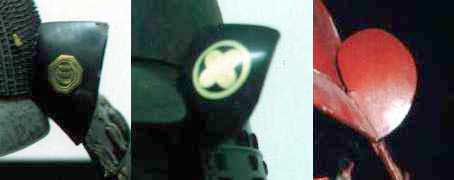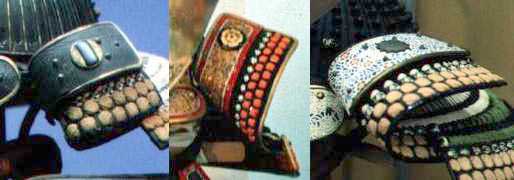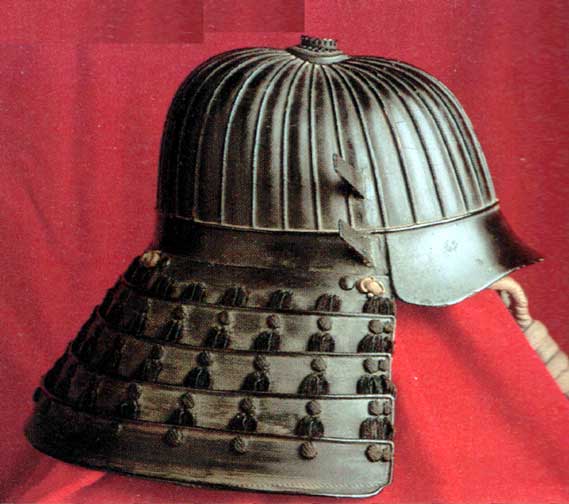Chapter Eight:
The Kabuto
There are actually two parts to a kabuto: the hachi (bowl) and the shikoro (nape-guard.) In this chapter I will present some of the more common varieties of both. In the next chapter I will explain the various methods of construction.
Hachi
Rounder hachi were less common in the late 1500s, but were standard in the eleventh to fourteenth centuries. In the 1500s, a wider variety of helmet shapes existed, and most were at least vaguely head-shaped when seen from above.
Multiplate
Even though very few helmets are made of one single plate, the term “multi-plate” is used to refer specifically to helmets which have a number of plates that are roughly the shape of pie wedges. The so-called three-plate (aka hineno or etchū) zu-nari (head-shaped) helmets, although made of more than one plate, do not therefore fall under this category.
There are several types of multi-plate which are differentiated by shape. The number of plates itself is incidental. The same helmet style can be rendered in eight, 16, or even 120 plates, with ribs, protruding rivets, or smoothed plates.
Most common shapes of multi-plate-type hachi.
Multi-plate helmet bowls made during the latter part of the sixteenth century are of three types: suji kabuto, koboshi kabuto, or hari bachi. Suji kabuto can be identified by the ribs that stand up at the edge of each plate (suji means “tendon” or “line”). Koboshi kabuto exhibit myriads of small, stud-like rivets on the helmet bowl (koboshi means “small star”). Hari bachi are multi-plates in which there are no ribs on the plates, and the rivets are typically filed flush (hari means “spread on”).
Sujibachi (Note the holes in the koshimaki for attaching the shikoro; note also the shiten-no-byō and hibiki-no-ana on the hachi itself.)
Haribachi (The one in the middle is actually an 8-plate haribachi with lacquer built up to make it look like a 62-plate sujibachi.)
Koboshibachi
Multi-plate helmets almost invariably have shiten-no-byō and hibiki-no-ana. These features are holdovers from the older construction methods. The shiten-no-byō are four small, protruding rivets in the same pattern as koboshi. Each rivet is placed high on the bowl (about where the bowl curves over), and at what would correspond to the NE, NW, SE, and SW corners of the bowl if north is taken to be front-and-center. Directly below this rivet is a small hole, the hibiki-no-ana. Originally, there was a knot of lacing at each hole, and the strips inside were part of the helmet suspension system; in the latter period, these holes were kept as a “tradition.”
Zunari
The zu-nari (“head-shaped”) kabuto is often referred to as a three-plate helmet. It is also called hineno-kabuto. Despite the implication with the name “head shaped,” there have been nearly round versions, almost pointed ones, versions with tall, domed bowls, and even examples with angular bowls, in addition to the more conventionally head-shaped models.
Structurally speaking, there are two primary types: one in which the koshimaki only reaches the visor (you can tell these by the small points of braid, which hold the lining inside the bowl, along the edge of the visor), and one in which the koshimaki is full-circle. This pattern is for the latter. What is the difference? With a full koshimaki, the ties holding the lining in are invisible; with a truncated koshimaki, the lining has to be tied to the visor, so lines of stitching are visible on it.
Front and side views of a typical hineno kabuto.
Technically, there are two types of “three-plater”—one is the hineno kabuto, the other is the etchū kabuto. They are almost identical except for one key difference: the central plate in the hineno kabuto goes under the visor; in the etchū kabuto, it overlaps the visor.
In addition, there is also another structural difference. In some models, the koshimaki is only long enough to reach from one edge of the visor around to the other edge. The more common model has the full koshimaki. In models with the shorter koshimaki, the lining is attached to the visor itself, a technique which can be observed by a cursory examination of the kabuto (the ties for the lining show at the pairs of holes on the visor bottom).
Grotesque
Kawari (“changed”) kabuto—or “grotesques”—are so called because they are different from the conventional helmet. They are usually built up of lacquer, papiér mâché, wood, etc., on a hineno kabuto bowl, but occasionally one can encounter particular types and exceptions that were made directly of metal. These grotesques take the form of sea monsters, animal heads, seashells, court caps, or other unusual objects.
Shiinari (acorn-shaped) kabuto.
Momonari (peach-shaped) kabuto. This design was very popular in the Sengoku period, and was inspired by the European cabasset.
Typical Features
The hachi is held together with a koshimaki, or skirt-plate, which encircles it at the base. The koshimaki is a single strip of metal that joins at the center-front, under the visor. The nape-guard is attached to the koshimaki, never to the helmet bowl itself.
Helmet bowls of multi-plate construction have a hole called a tehen in the center of the top where all the various pie-slice-shaped pieces meet. This hole is decorated with a tehen-no-kanamono. So common is this feature that by the end of the sixteenth century even some three-plate helmets boasted this feature, though they clearly didn’t need it.
Attached to the back of multi-plates (and occasionally three-platers) is a kasajirushi-no-kan, a ring designed to hold an identifying badge. In practice, the ring serves no function whatsoever.
Datemono (crests) could be attached to the front, sides, back, or even top of the helmet using a fixture called an oharaidate. Some helmets were even fitted with several different types of crest. Crests were usually removable. Even grotesques might have crests attached to them.
The mabizashi (visor) was slightly dished, and often had either a gilt rim (fukurin) applied to the edge, or it was given a slight lip. Some mabizashi were clad in printed leather, held in place by glue and a few well-placed sakura-byō.
Shikoro
The shikoro is a multi-lame skirt of scale or solid lames, which is attached to the koshimaki and protects the back of the neck.
The distinctive blowbacks on the shikoro, called fukigaeshi, originally had a very utilitarian purpose. They were designed to protect the lacing against a downward sword stroke which might sever the cords. By the sixteenth century, the fukigaeshi had become more vestigial, although they still served their function.
There were many styles, ranging from larger, full-sized models using two lames (or perhaps a separate plate extension), to simple little ear-shaped winglets. Their decoration was as simple as pierced, applied, or painted mon to applied panels of printed leather and gilt-embossed heraldic elements.
There are many varieties of shikoro:
Hineno-jikoro
The hineno-jikoro, the creation of an armourer known as Hineno Oribe-no-Kami, was very popular during the latter part of the sixteenth century. It was closer fitting, quite protective, and lightweight. All of these were arguments in its favor.
The fukigaeshi of hineno-jikoro are almost without exception of the small, ear-shaped variety, typically made in one piece with the hachitsuke-no-ita. The number of lames can range from four to six; typically it is five.
Ichimai-jikoro
The ichimai-jikoro, a shikoro consisting of only a single lame (hence the name), was very rare. Several examples survive, however, and almost all of them are on momonari kabuto. It has one clear advantage—a considerable reduction in mass and weight—but a resultant reduction in protection. A few examples may have been made with steeper shikoro, but the ones that survive are almost all broad and high, almost like the first plate in a kasa-jikoro.
The fukigaeshi of ichimai-jikoro are almost without exception of the small, ear-shaped variety.
Kasa-jikoro
The kasa-jikoro derives its name from the kasa, or umbrella. The earlier period kasa-jikoro were almost parallel to the ground, but those of the sixteenth century were more down-ward sweeping. They still retained a wider silhouette and so retained the name.
The fukigaeshi styles used ran the gamut from sublime to rediculous. Most commonly, kasa-jikoro had three lames.
Ichimanjū-jikoro
Ichimanjū means “one curvature” and derives from the fact that only the hachitsuke-no-ita really has any sense of a curve to it. Like the kasa-jikoro, it has a slight dishing in addition to its wraparound formation. Unlike the kasa-jikoro, however, the ichimanjū has five or six lames, and they extend out and down rather than just out.
Like the kasa-jikoro, any type of fukigaeshi is acceptable, but larger ones seem to work better. Most shikoro of this pattern have five lames.
Komanjū-jikoro
The previous shikoro type is sometimes confused with the komanjū, or “slight curvature.” It is more accurate to use the term “komanjū” with shikoro evincing a gentle sweep throughout all the lames, but not everyone makes such a distinction. In point of fact, this was virtually the default shikoro pattern.
In other ways—such as construction or styling of fukigaeshi—or it takes after the ichimanjū-jikoro. This one also typically has five lames.
Etchū-jikoro
This shikoro has lames that are virtually straight with a flat profile. It may descend straight down, or warp out slightly. In most ways, it conforms to the aesthetics and decorative styles of the hineno-jikoro, and so usually has smaller fukigaeshi as well. It also has the same lame count, typically, as the hineno-jikoro.
This type of shikoro can be equipped with any type of fukigaeshi.
Gesan-jikoro
The gesan-jikoro has a conventional hachitsuke-no-ita, but the other lames—whether three, four, or five more—were made of three separate sets of lames like sets of kusazuri. In fact, that is what gesan means. Often, small strips of metal were used to help hold the lames out and in their proper shape. Armour historian Sakakibara Kōzan praised them for their practicality, although they were comparatively rare.
Kusari-jikoro
The kusari-jikoro is formed from a single panel “skirt” of fabric faced with mail (hence the name “kusari”—mail—shikoro). Sometimes the skirt is made in multiple sections like the gesan-jikoro. Often, as well, the skirt may be covered with small metal plates in addition to, or instead of, mail. Such a shikoro was a “low rent” piece and would not as a rule have been worn by men of rank.
Obviously, it would be impossible to have a fukigaeshi attached to such a construction.
Fukigaeshi
Originally, fukigaeshi (lit. “blow-backs”) were made from the entire front sections of the shikoro, or all but the bottom-most lame. The original purpose of the fukigaeshi was to prevent a downward sword blow from slipping between the lames of the shikoro and severing the suspensory lacing. By the fifteenth century, they were greatly abbreviated, and were made up only of the top two lames with a mild sweep backward. By the end of the sixteenth century, they were even more vestigial, often being little more than ear-like flanges emerging from the top-most lame (the hachitsuke-no-ita) of the shikoro. In fact, some helmets didn’t have fukigaeshi at all.
The fukigaeshi was often decorated with the wearer’s mon. This could take the form of a gilt copper appliqué, a lacquer-painted crest, or in some cases even pierce-work. If the mabizashi was covered with printed leather, the fukigaeshi usually received the same treatment (and in this case, the crest would have to be a separate piece of applied metal).



Other Features
Some shikoro are attached to the koshimaki with ornamental rivets (hassō byō) seated on hassō kanamono (see the chapter “Before Beginning” for details on these fittings). The only difference between these and other conventional hassō kanamono is that those for the shikoro arc slightly and follow the curve of the hachitsuke-no-ita. Most helmets didn’t have this feature, however.
The bottom-most lame of the shikoro is no different from the other dangly bits on the armour. In most armours, the bottom-most lames are detailed with a row or two of crosslaces, even if the armour is laced in sugake odoshi. Rarely, as in the example of the koboshi kabuto illustrated above, the bottom-most lame is covered with an ornamental fringe strip of bearskin.
Sometimes, there was a second hanging guard worn under the shikoro. This was called a shita (“under”)-jikoro. Most shita-jikoro took the form of a skirt, or several panels forming a skirt, made of brigandine, although others were covered with mail or even made of sane sewn to a fabric backing. Uesugi Kenshin had several kabuto incorporating this extra protective feature.
One of Kenshin’s kabuto with a shita-jikoro. This one is made of sane attached to a fabric backing forming a three-panel skirt that defends the neck where thekasa-jikoro won’t. Note that the layers overlap in the reverse way to conventional lamination.
Kabuto Gallery
The following graphics link to larger images (some are very large) which will pop up in a separate window so you can look at several helmets.






































